By Virginia Daffron and Brooke Randle
As Asheville awaits the Tuesday, May 14, culmination of a battle royal over the proposed conversion of downtown’s iconic Flatiron building from offices to an 80-room boutique hotel, the time seems right to check in on the local hotel scene. From now through the end of the year, 465 new rooms are expected to join the nearly 8,000 already operating in Buncombe County. With many more approved and under construction in 2020 and beyond, just keeping track of what is being built where and by whom is no small challenge.
In response to community concern that the pace of new hotel construction had gotten out of control, on Feb. 14, 2017, Asheville City Council changed the standards for hotels and large buildings seeking approval within city limits. Whereas most projects up to 175,000 square feet and 145 tall had previously been approved by the city’s Planning & Zoning Commission, the changes meant that hotel projects of more than 20 rooms and any building over 100,000 square feet in size now require Council approval.
How much difference the shift has made, however, is hard to gauge.
While the increased level of scrutiny may have discouraged some developers from bringing new projects forward, many have run the gauntlet to receive Council’s approval. Since the new rules went into effect, Council has given the nod to seven of the eight new hotel projects that have come before it.
Three of the projects were approved by the previous Council, which included members Gordon Smith and Cecil Bothwell. In December 2017, Council members Vijay Kapoor and Sheneika Smith filled those two seats.
Here’s how the votes went down:
- Hotel Krish, 86 rooms, 1500 Tunnel Road, approved July 25, 2017, by 6-1; Vice Mayor Gwen Wisler voted no.
- Innsbruck Hotel by Candlewood Suites, 49 Tunnel Road, approved Aug. 22, 2017, by unanimous vote.
- Boutique hotel, 95 Roberts St., approved Oct. 24, 2017, by 5-2; Wisler and Gordon Smith voted no.
- Hilton, 390 Airport Road, approved Jan. 23, 2018, by 5-2; Brian Haynes and Kapoor voted no.
- Mainstay Suites at Brevard, 511 Brevard Road, approved Oct. 9, 2018, by 4-2; Haynes and Julie Mayfield voted no; Kapoor was absent.
- Extended stay hotel, 324 Biltmore Ave., approved March 12, 2019, by 4-3; Haynes, Wisler and Keith Young voted no.
- Family Lodge, 155 Biltmore Ave., approved March 26, 2019, by 4-3; Haynes, Sheneika Smith and Wisler voted no.
The most consistent hotel opponent has been Haynes, who has voted against approval five times; Wisler has voted against approval four times.
The sole hotel denied under the new rules, a 170-room project at 62 Fairview Road on the outskirts of Biltmore Village, failed on a 6-1 vote, with Wisler in opposition.
Lodging facilities outside city limits, of course, are not subject to City Council’s review and are considered under county zoning ordinances, which are less restrictive.
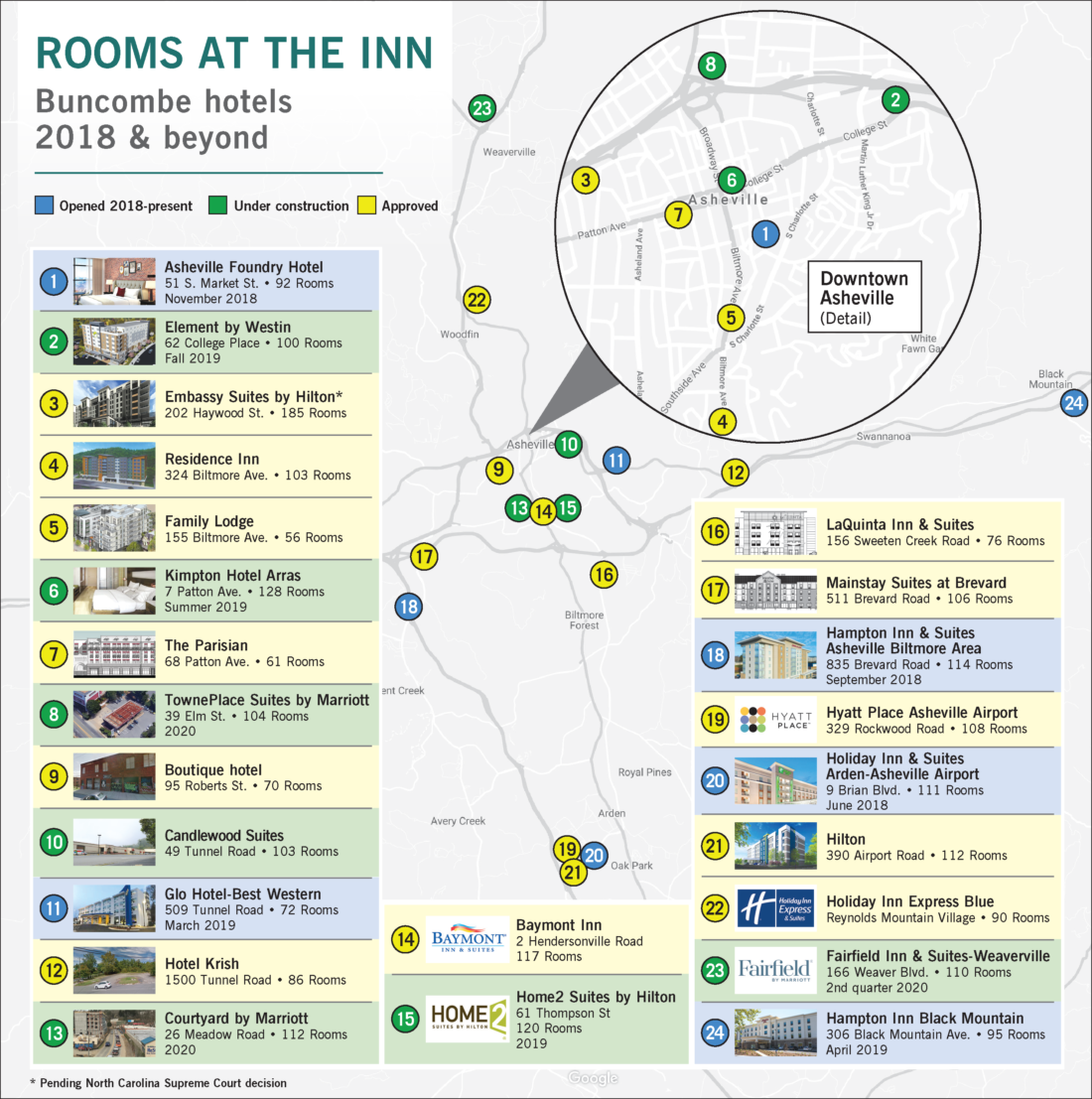
Occupancy tax
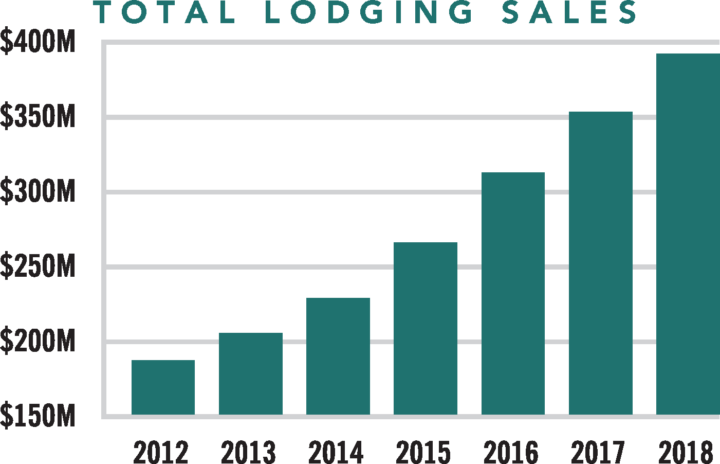
In what the Buncombe County Tourism Development Authority describes as an “unprecedented” move of self-imposed industry taxation, hoteliers in 1983 advocated for the creation of a local occupancy tax, which was passed into law by the N.C. General Assembly. The industry wanted the revenue to be invested in marketing and advertising efforts aimed at placing “heads in beds.” What began as a 2% tax rate increased over the years, jumping to today’s level of 6% in 2015. Visitors also pay a local 7% sales tax, totaling 13% tax for each night of stay. The occupancy tax also applies to rooms or houses rented out for stays of fewer than 30 days, often through online companies, including Airbnb. Asheville’s growth as a national tourism destination has been a boost for the occupancy tax, which generated $23 million in revenue last year.
Stoking the tourism engine
Three-quarters of the revenue is designated for advertising and public relations efforts to increase tourism and overnight stays. The remaining 25% flows into the Buncombe County Tourism Product Development Fund, which provides grants to projects with the potential to boost tourism throughout the county. So far, the BCTDA-directed agency has awarded $44 million to 39 different tourism-based community projects, including improvements and updates to the YMI Cultural Center and the Grove Arcade, renovating and expanding the Diana Wortham Theatre and developing an African American Heritage and Cultural District that aims to connect downtown Asheville to the city’s historically African American neighborhoods.
The TDA announced earlier this year that it will pause new funding awards from the TPDF while it undertakes a yearlong Tourism Management and Investment Plan process to examine the role of tourism in the community.
No money from the occupancy tax goes directly to city infrastructure or operations, meaning that city property owners foot the bill for police and fire service, road and sidewalk repair and construction, and the costs associated with managing and cleaning up after large numbers of visitors.
Millions visit
The number of people spending time in Buncombe County has risen sharply over the past few years. In 2017, 11.1 million people visited the county — 3.9 million of whom stayed overnight. A surge of new hotel rooms has both driven and served the growing demand. Even in the face of an abundance of lodging options, hotel occupancy rates climbed to 73% in 2017. And while a presentation by industry watcher STR Inc. delivered in January shows that occupancy rates in Asheville may be beginning to level out and describes future growth as “tepid,” local rates remain nearly 10 percentage points above the national average.
Living like a local
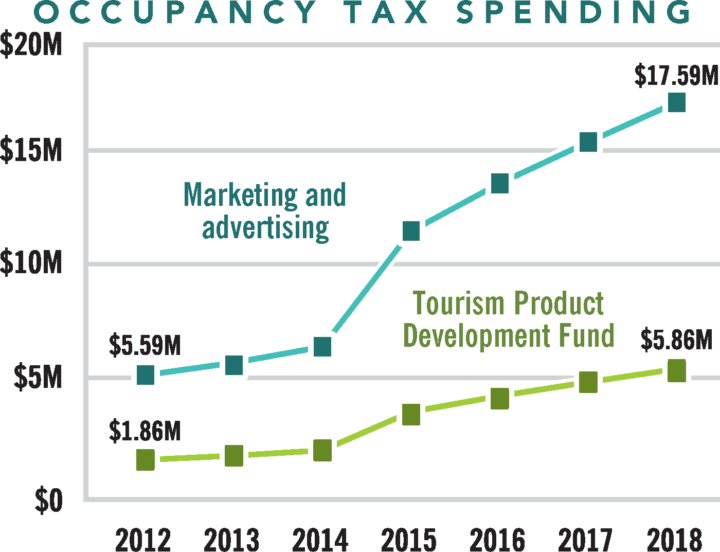
According to data from the BCTDA, vacation rentals accounted for 15.25% of total room sales in Buncombe County for fiscal year 2018-19 with sales of nearly $60 million. Collections through March of the current fiscal year total about $50 million, putting the county on track to significantly exceed last year’s collections.
While the city places restrictions on short-term rentals, data compiled by financial technology company Smart Asset found that Airbnb listings alone represented 3.2% of available housing in Asheville and ranked the city No. 1 for the number of listings compared with units of housing stock in the entire United States. The company also estimates that Airbnb rental rates bring in about four times as much as long-term local rentals. Some local activists have suggested this difference in revenue between short- and long-term rentals may incentivize property owners to convert their homes into vacation rentals, exacerbating the area’s affordable housing crisis.
Advertising Asheville
The primary audience for the Buncombe County Tourism Development Authority’s tax-funded ad campaigns is well-heeled older adults — “elite empty nesters” — who spend a significant portion of their time and money on travel, the arts and culinary experiences, according to the TDA’s 2018-19 marketing plan. Secondary groups the agency targets include engaged couples, families, retirees, millennials and business meeting planners.
Advertising efforts focus on four core geographical areas: Atlanta, Charlotte, Greensboro/Winston-Salem/High Point and Raleigh/Durham. Other regional targets include Knoxville, Tenn., and Columbia, Charleston and Greenville, S.C. The authority has also defined “expansion” markets such as Nashville, Tenn., Washington, D.C., and large metro areas in Florida.
That’s all to point out: This is no shoestring marketing effort. The Explore Asheville Convention and Visitors Bureau, the TDA-funded operation that runs the advertising, public relations, marketing and group sales efforts to promote Buncombe County, has demonstrated consistent skill and success in drawing tourists to the area.
The TDA voted in January to shift its ad agency of record from New Orleans-based Peter Mayer to Atlanta- and New York-based 360i. “The agency will support Explore Asheville in generating national brand awareness that will continue to fuel tourism’s annual economic impact of $3.1 billion in the community,” the authority said in a press release about the company’s selection.

On April 24, creative staffers from 360i presented the authority board with concepts for a planned two-year advertising campaign that will span television, digital platforms and print publications. “Let your spirit run free,” urges the planned tagline for the campaign.
One of two planned TV and online video ads “is told from the perspective of a woman who has lived in the Asheville area for many years and experienced all the surprises a visitor will have in store. … The viewer’s outtake? If Asheville has enough surprises to last a lifetime, you’re guaranteed a fair few of them when you visit,” the ad reps told board members. Another ad will focus on “how the Asheville area is so rich in surprises every single day that it’s perfectly reasonable to expect them.”
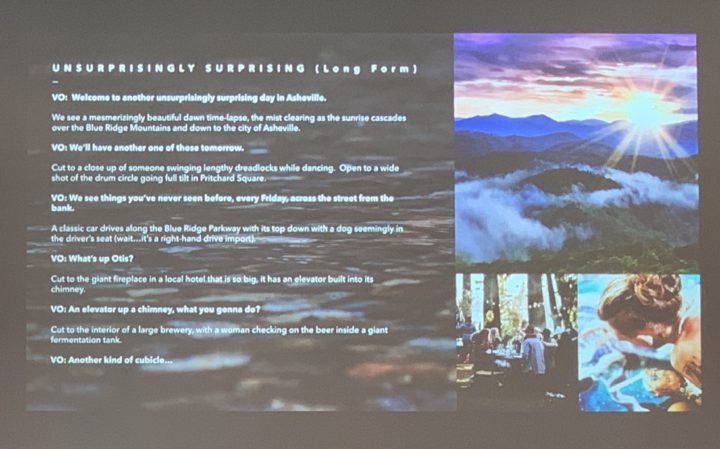
The price tag for cinematography, music, photography, talent and other services to create the new campaign is estimated at $950,000. Agency staffers told the board that local talent will be commissioned whenever practical.


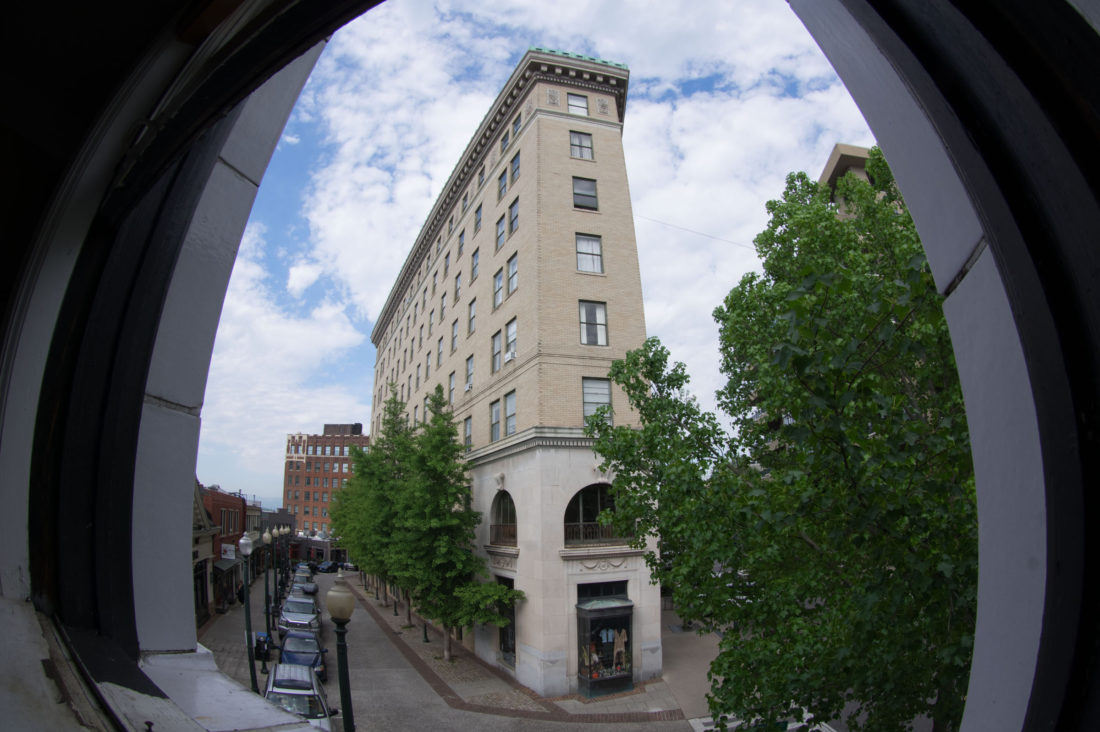
As ever, Virginia provides a thorough overview of the Hotel Situation: thanks for your diligence.
But: we get told about the number of hotel rooms and occupy rate on a monthly basis, thanks to the [still-unaccountable] TDA gleefully providing the data, so it’s perhaps an easier story to write than what the hotels are now replacing.
How much office space is in the city, especially downtown, compared to five years ago? The BB&T wasn’t especially up-to-date office space, but it was 18 stories of office space and now it isn’t. The Flatiron is very much not deluxe office space, but it’s office space, and the developers’ “generous” offer of six months’ rent assistance to its tenants counts for nothing if there’s nowhere vaguely comparable to rent (in terms of square footage more than cost).
Just as AirBnB has eaten into long-term residential rentals, this late stage of the hotel bubble is cannibalizing the city’s commercial rentals as property owners and developers try to cash out. That’s a very unbalanced portfolio.
Thanks for the suggestion on returning to the subject of downtown office and retail space, which I last looked at almost three years ago: https://mountainx.com/news/land-of-the-sky-high-rentals/
(You’re right that in some ways it’s a more challenging topic, but the data are certainly available in the databases of commercial real estate brokers.)
That was a great piece, Virginia, though more focused on retail space which has its own demands in terms of location and visibility. (You can’t cover everything in detail at once!)
Asheville has a lot of self-employed professionals who don’t need a lot of office space, but they do need a space to meet their clients: therapists, sole-proprietor CPAs and lawyers, etc. Coworking spaces aren’t a good fit, nor are rent-by-the-day offices. They need 150 sq. ft., not a 1500 sq. ft. property that they’re not allowed to divide into separate spaces in order to make the rental math work. That kind of office space barely exists — not just in downtown, but across the city — and its scarcity affects people’s ability to do business. There is demand, but no supply, because the economic returns on hotel/condo development are more attractive to individual property owners. Where there is supply, the rental premium has consequences: therapists are less likely to accept insurance or see Medicare clients, lawyers less likely to do pro bono or reduced-fee work.
We’ve reached the point where every approval decision is not exactly zero-sum but is a clear choice with direct repercussions on the economic makeup of downtown: whether to sacrifice one kind of work for another that pays less and serves tourists (and the TDA’s ad budget) instead of residents. Those decisions compound over time.
My husband is an architect in solo practice so — yes. I understand the issue and I agree it’s different from retail rental rates or office space for corporate tenants.
You lay it out very well and again I agree that it would make a splendid subject for an article.
A couple of thoughts on all this; might ruffle a few feathers. Oh well.
1) Tourism in Asheville is largely a dead end industry. Think about it. First there is the terrible US economy. In spite of all the fake news, the structural flaws are huge and growing. The next downturn (and we will have one) will wreak havoc on folks discretionary spending. Of course, those with money will continue to come to the high end places like the Grove Park Inn, Westin, Grand Bohemian, etc. But this won’t carry the city. Second is climate change. This is coming faster and stronger than most have anticipated. If rainfall amounts continue to grow, tourists will be disappointed and stay away. All that said, even if these significant issues weren’t on the table, tourism is a very iffy mainstay economy because of its clear cyclical nature.
2) The NC Legislature geniuses are using (prostituting might be a more accurate word) Asheville and the Tourism Board to promote development in western NC. They don’t give a shit about quality of life or any of those “little people” considerations. They’re interested in producing/selling lots and lots of concrete, steel, asphalt, wood, and lining the pockets of all the associated companies that deal in these products a and who lobby the legislature’s weak minds for this stuff. Of course they like to pat themselves on the back with the additional tax revenues that come from the growth. Of course they will parrot the oft remarked phrase that all this means more jobs. Well yes that is true, but most are not that well paying and the real benefactors are the owners of these companies.
3) On more hotels in Asheville, I really dont’ care. Build them as long as they aren’t ugly or overly large for the area. When the big downturn comes and they can’t make a go, we’ll buy them on the cheap and turn them into affordable housing/quasi retirement centers. You laugh? Even though rooms don’t have kitchens, a main floor kitchen could be added. The buildings are generally of very sound construction, sprinklers, all the same code requirements of multi-family. This is what will happen to them when the SHTF and we have to adapt.
4) What I’d like to see is ALOT more focus on the crappy infrastructure of Asheville for the VAST majority of people that don’t give a hoot about tourism. Our water system (pipes) is a joke! The roads are not maintained even to basic levels. Storm water infrastructure is going to be critical in coming years and is way behind the curve. But of course, these are trivial items for our local government. They are more concerned with critical issues like approving hotels.
Thank you Virginia Daffron for some excellent and much needed context and analysis on the broader issue of hotels and tourism in Asheville. And I think Mike R. has expressed what many locals feel about the subject. Some on the city council have increasingly expressed concern about Asheville becoming the economic equivalent of a classic Central American “one crop economy.” There is good reason for them to be expressing those concerns. And woe onto us (the residents and workers) if/when something happens to the tourist harvest.
However, it is not enough to recognize the issue. The Council needs to start drawing more hard and fast lines in its decision making in order to curtail the singular and still growing dependence on tourism. Sometimes that might mean saying “No” to a project, without yet necessarily having an answer to what else might be done with an existing building or a particular parcel of land. Otherwise, they become captive to the argument, which we are hearing with increasing frequency, that the “only feasible plan” is to build or convert a structure into a hotel.
As it applies to the Flatiron proposal, it is not the job of the Council or of residents who oppose or at least have serious concerns about its conversion into a hotel, to come up with an alternative plan. For now it may be enough to “just say no,” and ask that people go back to the drawing board with a more creative proposal.
The Grove Arcade was saved by turning it into a mixed use combination of retail, offices, and residences. Although it certainly is also a stopping point for many tourists, it first and foremost serves local businesses and residents in a number of different capacities. I have little doubt that if its restoration were being debated today, that it too would be the subject of the argument that turning it into a hotel is “the only feasible solution.” At a minimum, the Council should be willing to pushback. There is a difference between “the only feasible” use of a property, and what is simply “easiest and most profitable in the short term.”
Would condos or apartments be an acceptable option for those who oppose the hotel option?
Once there’s comparable vacant office space elsewhere for the current Flatiron tenants, sure, whatever. The issue isn’t what might be added, it’s what’s being taken away.
Curious, apparently any sort of residential conversion would not be eligible for historic preservation tax credits. It must be an income-generating, nonresidential use to qualify.
Thank you for that information. General citizens/readers don’t have enough information on this project to form an objective opinion. The anti-growth people don’t want a hotel. is there any info/study on just what types of development projects would be economically viable for that building?
“Anti-growth” is weasel words. What precisely constitutes “growth” in turning the Flatiron into a hotel?
Growth in Asheville would encompass mixed-use space to reflect the needs of income-generating, taxpaying residents, instead of me-too projects. Instead, developers are risk-averse and seek safety in numbers: if the economy tanks on your hotel project, everybody building hotels takes a hit. If you do something different, you put yourself out on a limb.
I am nostalgic for the days when downtown was a quiet place during the day, with plenty of parking, and even quieter after 5:00 pm, with no one on the streets. Peaceful. When the Hot Dog King was still there, and that plumbing store with toilets in the window was a sight to seen on Biltmore Avenue. Then the gentrifiers and the tourists and the hotel builders and the high-priced restaurants came and spoiled our town. There used to be an inexpensive Chinese restaurant downtown. Does anyone remember it’s name? Wasn’t there a nice newsstand on College Ave, near the old watch repair shop? There was even a farmer’s market on Lexington Ave, if I’m remembering correctly. At least the pawn shop is still there.
I remember the Chinese restaurant. It had a neon sign. I even shopped at Woolworths and JC Penny when they were around. Finklesteins actually had guns for sale in the window. The plumping place you wrote about was called Roger’s. And I’m old enough to remember Ed Orr Motors. And the Coke lady.
Yeah the outsiders have been the worst thing to happen here. By far.
“Yeah the outsiders have been the worst thing to happen here. By far.”
Aside from your property valuation. Nobody’s holding property owners hostage if they want to cash out and move back to the 1970s.
The place was called ‘Paradise’. We went once a month when I was a child. Usually before heading to Dreamland for a drive in film.
Ahhhhhhh….. I miss it.
What I have been watching or reading from the overly white BCTDA camp makes me puke in my mouth a bit too often. Its use of the “hotel tax” is harmful to visitors as well as our own community. $23M for advertising alone. What a sham to pay their all white staff huge salaries while “gifting” menial funds to placate folks with crap like what they have done to Eagle street to ‘honor’ Black History vs. a thriving Black Culture since this city has gentrified the hell out of every nook and cranny of what non-white culture there was here. Its just gross. Really.